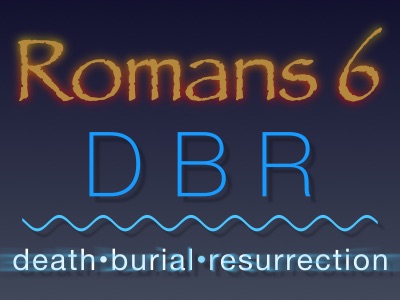
Here is the first scripture we use to argue that water baptism is necessary for salvation. It’s Romans 6:1-11. This is a long passage holding wonderful treasures, the first of which harkens back to our lesson about the correct method of baptism. Let’s listen to it.
Romans 6:1-11
“What shall we say, then? Shall we go on sinning so that grace may increase? By no means! We died to sin; how can we live in it any longer?Or don’t you know that all of us who were baptized into Christ Jesus were baptized into his death?
We were therefore buried with him through baptism into death in order that, just as Christ was raised from the dead through the glory of the Father, we too may live a new life.
If we have been united with him like this in his death, we will certainly also be united with him in his resurrection. For we know that our old self was crucified with him so that the body of sin might be done away with, that we should no longer be slaves to sin–because anyone who has died has been freed from sin.
Now if we died with Christ, we believe that we will also live with him. For we know that since Christ was raised from the dead, he cannot die again; death no longer has mastery over him. The death he died, he died to sin once for all; but the life he lives, he lives to God.
In the same way, count yourselves dead to sin but alive to God in Christ Jesus.”
Romans 6 – Verse by Verse
Wow. What a rich passage of scripture. Let’s dissect this verse by verse.
Verse 1-2
“What shall we say, then? Shall we go on sinning so that grace may increase? By no means! We died to sin; how can we live in it any longer?”
The first part of this verse addresses a misunderstanding in the early church where some people thought that if they sinned more, God’s grace was revealed even more. Paul says, in effect, “That dog don’t hunt so stop thinking that way.”
But notice something. Paul is addressing people who are already saved. How do we know this? Because all of it is in the past tense. He identifies them as people who have (past tense) “died to sin.” If someone has “died to sin” that means that their sins have been forgiven and they are no longer living a life of sin. These are people who have died and been raised again to their new life in Christ. They have been Born Again. Let’s dig a little deeper and ask the critical questions: “When did this happen and where did it happen.” Paul answers these questions in verse three.
“Or don’t you know that all of us who were baptized into Christ Jesus were baptized into his death?”
Baptized into His Death
In this sentence, Paul tells us this “death to sin” occurred when these people were baptized into Christ. He tells us they were “baptized into his death.” Ah… two critical truths! First, we get “into” Christ through something called “baptism.” Second, we learn this “baptism” places us “into Christ’s death.” These are important truths to understand.
There is no other way, in all of scripture to get “into” Christ or “into his death.” And to be clear… these are not symbolic things. These are, what I like to call, “reality things;” things which are really happening. At the time of baptism, we are put into Christ and into his death by the Holy Spirit. But the process does not stop there. We are not left dead and buried, just as Christ was not left dead and buried.
Verse 4
“We were therefore buried with him through baptism into death in order that, just as Christ was raised from the dead through the glory of the Father, we too may live a new life.”
Buried with Him
There is a lot here! This verse begins with the word, “therefore.” In my early years as a disciple, I was taught that whenever you see the word “therefore” in a scripture, you should always back up a few verses and find out what it is there for! If we do that, we must read verse four in light of verses 1-3.
Click here to read the rest of this post.Podcast: Play in new window | Download (Duration: 19:13 — 16.5MB) | Embed

